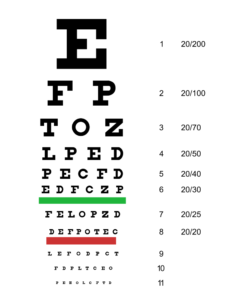Ultra-HD and 4K TVs are quickly coming down in price, and manufacturers are pushing them as “the next big thing.” Is it worth upgrading? A central issue here is, can the typical consumer notice the difference? It all has to do with how far you set from the display, as this will limit one’s ability to perceive small detail.
 So what is the practical viewing distance for a display? People with “20/20” vision have a visual acuity that can resolve 60 features per degree, or 30 cycles per degree. From this, we can calculate that the “optimum” distance from which to observe a 1080-line display is about 3.2 times the picture height, where the vertical viewing angle is 18 degrees. Further than that, and a person with 20/20 corrected vision can’t resolve the smallest displayed details; closer than that, and you’ll start to see individual pixels.
So what is the practical viewing distance for a display? People with “20/20” vision have a visual acuity that can resolve 60 features per degree, or 30 cycles per degree. From this, we can calculate that the “optimum” distance from which to observe a 1080-line display is about 3.2 times the picture height, where the vertical viewing angle is 18 degrees. Further than that, and a person with 20/20 corrected vision can’t resolve the smallest displayed details; closer than that, and you’ll start to see individual pixels.
Stated in screen diagonals, this works out to 1.55 times the diagonal measure of a 1920×1080 display. For a 1080-line display with 42” diagonal, the optimum viewing distance works out to be about five-and-a-half feet.
But at 4K resolution, in order to resolve 30 cycles per degree, the optimum distance becomes about 1.5 picture heights, or about 0.75 screen diagonals. For an 84” set, that means sitting at about 5.3 feet from the screen — a truly immersive experience, as the horizontal angle subtended by the display would be about 60 degrees, or about half of the normal binocular range of human vision.
Funny enough (or is it?), the 84-inch Sony Bravia is said to have a viewing angle of just that: 60 degrees. But at a smaller screen size, like 42″, the optimum distance is just 32 inches, which is not at all practical, unless you plan to use that as an ultra-large computer monitor.
These calculations assume that there are no other limiting conditions; in reality, factors based on Kell factor, interlace, the inter-pixel grid, contrast and the sharp edges of image details must all be taken into account. Also, because most people view their TV from a larger distance of about 9 feet (the so-called “Lechner distance,” named after RCA researcher Bernie Lechner), the required optimum screen size grows proportionally.
NHK researchers wrote in a 2008 paper that test subjects could distinguish between images with effective resolutions of 78 and 156 cycles per degree. This suggests that some people can tell the difference between a display with 1080 lines and one with 2160 lines, when viewed within the practical confines of a living room.
Of course, 4K sets come bundled with other features that exceed the capability of HD sets, like 60 fps (or higher), and 10-bit color – with 12-bit on the way. Just emerging, too, are sets with High Dynamic Range (HDR), which provides an improvement in perception of reality that, in many cases, can exceed that of 4K alone.
Time to get a bigger house?
–agc